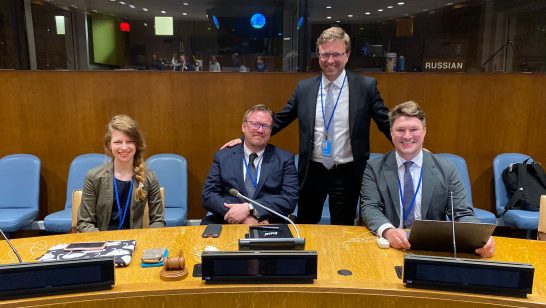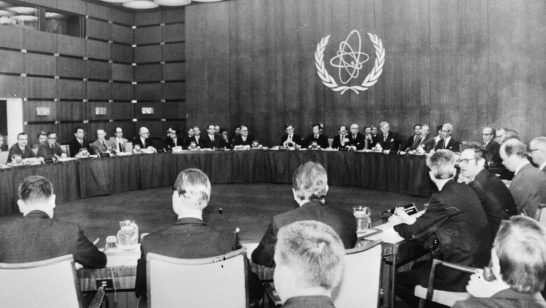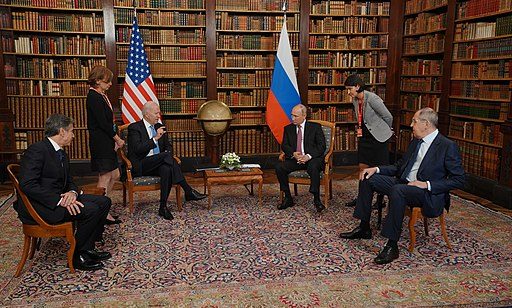
With the eleventh Review Conference (RevCon) of the nuclear Non-Proliferation Treaty (NPT) slated for 2026, the first session of its Preparatory Committee will be held this year in Vienna. As the NPT cycle has been cut to four years instead of five due to pandemic-related delays, there is limited time for considered reflections on the ‘failure’ of the Tenth NPT RevCon to produce a final consensus document.
Given the prevailing international security environment, the near possibility of a ‘successful’ tenth RevCon was surprising. The Russian delegation’s last-minute decision to block consensus was equally surprising and ultimately led to the conference’s failure. Russia’s actions were especially disappointing, considering that numerous delegations were prepared to set aside their misgivings about the final document and join the consensus. With the exception of Russia, the symbolic importance of adopting a ‘middle-ground’ outcome document on the 50th anniversary of the treaty was widely understood to be of paramount importance.
Understandably, reflections on the tenth RevCon have mainly focussed on assigning blame, whilst others have analysed what went wrong. While Russia rightfully deserves the lion-share of condemnation for the failure of the conference, beyond this, some degree of culpability lies with the nature of the review process itself. Important RevCon decisions have increasingly been reached during unofficial negotiations carried out by small groups of states. These negotiations have become so commonplace that RevCon participants even expect the conference president to facilitate (or at least ‘bless’) these proceedings. Such a dynamic invariably leads to opacity and the exclusion of some states and civil society.
Amongst the numerous shortcomings of such a dynamic, this RevCon suffered because Russian disengagement from the process was barely visible until the last moment. Increased transparency might have enabled states to identify Russian resentment before it was too late. Similarly, the reliance on the production of a single outcome document as a ‘litmus test’ of the treaty’s viability is proving to be less realistic as the treaty limps on. In this regard, Bob Einhorn provided ample alternatives which require serious consideration. The reluctance of President Zlauvinen to put the outcome document to a vote, following Russia’s blocking of a consensus, was the final nail in the coffin for the RevCon. In fairness to the President, he argued that a vote might invariably set a precedent that could eventually erode the consensus rule in future RevCons. These and many other shortcomings of the review process warrant sustained analysis and attention for the benefit of the upcoming review cycle.
However, the pessimism which underscores reflections of the tenth RevCon, should not obscure the remarkable successes that were also achieved in New York. Successes which, if adequately appreciated, might reinvigorate deflated delegations as they enter the next review cycle. To identify some of these successes, let me pose a slightly different question: “Had the RevCon not failed, would we have had a significant and valuable outcome document?”
From the perspective of the non-proliferation and disarmament pillars of the treaty, the simple answer is no. The outcome document reveals that very little progress was made in these pillars. The worsening international security context and the fundamentally polarised perspectives on the feasibility of disarmament proved to be insurmountable challenges. As a result, the outcome document merely deflected from these issues by using language that either papered over current challenges or watered-down states’ commitments in search of the lowest common denominators. In the end, the few paragraphs which sought to record the reality of the situation in Ukraine were identified by Russia as the reason for its walk-out.
But in sharp contrast with the non-proliferation and disarmament pillars, the outcome document reveals that a significant reinvigoration was taking place in the third pillar- where deliberations on peaceful uses of nuclear energy occurred. For context, pillar III deliberations usually result in the reassertion of the rights of states parties to full access to nuclear material, equipment, and technological information for peaceful purposes. These deliberations also usually reiterate longstanding calls to eliminate undue constraints to technology transfer. Throughout the past two review cycles, some influential NNWS’ have cemented their resistance to additional non-proliferation obligations – even when such obligations are beneficial. This resistance has been based on a perceived prioritisation of the non-proliferation pillar over disarmament and peaceful uses, and it has hampered cooperation on many issues pending a rebalancing of the NPT’s three pillars. This RevCon was no exception in this regard, as familiar positions endured.
...the outcome document reveals that a significant reinvigoration was taking place in the third pillar- where deliberations on peaceful uses of nuclear energy occurred. Olamide Samuel
Yet, unlike the first two pillars, pillar III deliberations in main committee III (MCIII) were largely reported to have been constructive, non-contentious, forward-looking, and ambitious. The outcome of these deliberations was a document that offered progressive solutions by identifying how the treaty plays a role in mitigating some of the most pressing human and environmental security issues of our time. The potential for peaceful uses to alleviate the negative impacts of climate change and accelerate the socio-economic development of the world’s most vulnerable was robustly articulated. Given the significant global changes that have occurred since 2015, it would not have been possible to recycle old language from previous RevCons. As a result, delegates had to focus on developing new language that could describe the changed global context in light of ‘newly’ understood existential risks stemming from the climate emergency, and finding creative solutions to them.
...delegates had to focus on developing new language that could describe the changed global context in light of ‘newly’ understood existential risks stemming from the climate emergency, and finding creative solutions to them. Olamide Samuel
For the first time in the history of the RevCon, NPT states parties were called upon to cooperate with ‘non-traditional partners’, including development agencies, the private sector, and multilateral financial institutions, to support the implementation of the UNSG’s sustainable development goals (SDGs). The SDGs have been a new development since the conclusion of the last RevCon in 2015, and their inclusion in the process should be seen as a positive development. The International Atomic Energy Agency (IAEA) was clearly identified as the preferred focal point through which many of these programmatic aspirations could be operationalised. As opposed to the widespread perception of the IAEA as just a ‘watchdog’, its numerous activities (such as the Peaceful Uses Initiative, the Renovation of the Nuclear Applications Laboratories, the Zoonotic Disease Integrated Action Project, and Rays of Hope—cancer care for all) were recognised as already catering to improving human and animal health, developing agriculture, managing water resources, combating poverty, and meeting increased energy needs.
By extension, the NPT was recentred as the forum within which cooperation on peaceful uses could be coordinated. This was demonstrated by a working paper submitted by a group of 32 states (including the US and UK – who now understand the implications of falling behind China and Russia as facilitators of nuclear technology transfer to developing countries). Finally, Pillar III deliberations also stayed in touch with relevant developments in the UN Climate Change Conference (COP) process. In the past few years, the IAEA has run increasingly successful advocacy campaigns, marketing nuclear technologies as integral solutions to climate change. COP27 featured a dedicated nuclear pavilion for the first time, where the IAEA’s Director General marketed nuclear as “part of the solution towards a decarbonised energy mix in the world”. In this regard, MCIII encouraged the IAEA’s continued sensitisation and advocacy campaigns for nuclear technologies at the COP conferences.
The progress made in pillar III was neither fortuitous nor peripheral. On the contrary, the peculiar success of this pillar was the result of long-term strategic planning leading up to the RevCon and could serve as a pragmatic example for states looking to strengthen the continuity between review cycles. Since the end of the 2015 RevCon, many parties recognised the need to leverage the peaceful uses pillar as a means of recentering the NPT as a beneficial endeavour for states – in developmental and socio-economic terms. The positive reception to the then RevCon President-Designate Rafael Grossi’s regional consultations geared at leveraging pillar III to salvage the NPT demonstrates the importance of such a strategy. These consultations were continued by current RevCon President Gustavo Zlauvinen, who also understood that ‘non-proliferation commitments enable peaceful uses, but it is the promise of the benefits under the third pillar that prop up the other two pillars’. Participants at the 2020 Wilton Park conference on NPT issues, mooted that peaceful uses could facilitate the momentum needed to counterbalance the glacial pace of progress made in the disarmament pillar. The result was an MCIII that lived up to its expectations and served as a crucial motivator for compromise.
Since the end of the 2015 RevCon, many parties recognised the need to leverage the peaceful uses pillar as a means of recentering the NPT as a beneficial endeavour for states - in developmental and socio-economic terms. Olamide Samuel
Without Russia’s blocking of a consensus on a substantive outcome document, there was every chance that Pillar III’s recentering of the NPT and IAEA would have been enshrined as an instructive outcome of the conference. Notwithstanding the general disappointment with the lacklustre non-proliferation and disarmament outcomes of the tenth RevCon, we should take stock of the successes recorded in the peaceful uses pillar as it could help us learn about future mechanisms for cooperation and success.
The opinions articulated above represent the views of the author and do not necessarily reflect the position of the European Leadership Network or all of its members. The ELN’s aim is to encourage debates that will help develop Europe’s capacity to address the pressing foreign, defence, and security policy challenges of our time.
Image: AFP Photo / Timothy A. Clary



